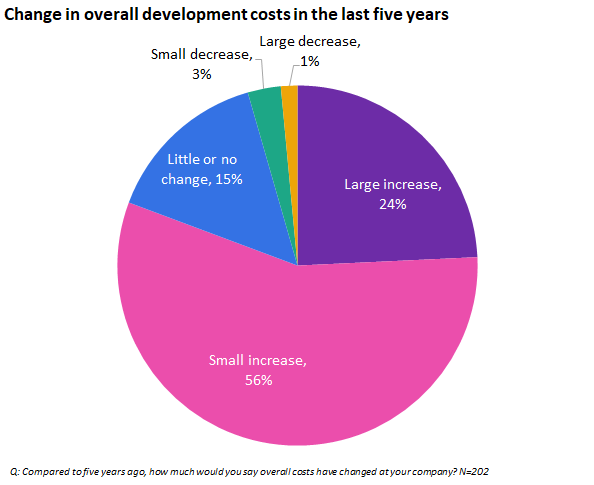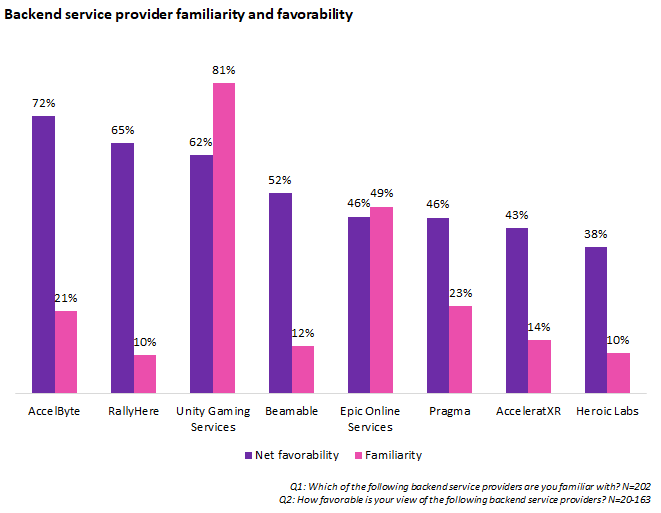Live service developers are increasingly looking to buy rather than build
This brand-new survey of live service developers around the globe covers all aspects of live service development in 2024 and sheds light opportunities and challenges live service developers should be aware of.
April 22, 2024

The increasing prevalence of live service games is one of the most unmistakable trends in the games industry in recent years. This is being driven both by player demand and that 50% of the top 25 gaming companies by revenue are publishing live service titles is impossible to ignore. The growing feeling among developers is that live service games open up the opportunity to create durable experiences that can be enjoyed over a long period of time, and in turn deliver steadier and more sustainable revenue streams.
While some of the opportunities in entering the live service market are clear, actually building and operating a live service game comes with plenty of challenges. To better understand these opportunities and challenges, Omdia partnered with AccelByte to create a brand-new survey of over 200 live service developers around the globe, covering all aspects of live service development in 2024.
Live service development is more accessible than ever
One of the clearest opportunities for game developers to emerge from this research is the increasing diversity of live service development. This is a model that has historically been associated with the mobile games market and a few large-scale megahits on PC and console. These days, however, we see the live service model being applied much more broadly.
Strikingly, 50% of the developers in our survey worked at companies with fewer than 100 employees, and more than one in five at studios of fewer than 10 people. We are now seeing widespread entry of small and medium-sized studios into the live service market—this is no longer a segment dominated only by the biggest and best-resourced players. Thanks in large part to the availability of cheaper and easier to use tools and infrastructure, live service development has been opened up to studios of all sizes.

Similarly, there is increasing diversity in content and platforms. Unlike the more casual and mobile focus of many early live service titles, the top genres among live service developers today are core gamer-friendly genres like action/adventure, RPGs, and shooters. There is also a greater cross-platform orientation. Developers were also as likely to be working on PC or console live service games as mobile, and some 59% were working on multi-platform titles.
This increasing variety in everything from project size to genre is naturally manifesting in other ways too. Developers are increasingly embracing a wide range of monetization strategies. Our research found an almost equal number of developers are opting for a premium upfront charging model as are relying on microtransactions. Additionally, we also saw significant numbers employing other models like in-game advertising, loot boxes, and battle passes. In fact, the average number of different monetization models per game was 2.8, underscoring how developers are employing a mix of strategies to best suit their game and their target audience.
Cost pressures are becoming acute
While developers are finding success in deploying a range of strategies to reach new audiences with live service games, they are also encountering plenty of challenges. Cost pressures are a major theme, with 81% of developers reporting their costs have increased over the last few years, a trend that most expect to continue.

Despite the recent wave of layoffs in the industry, hiring and talent is still a significant hurdle. A remarkable 90% of developers have found hiring to be a challenge at their companies. This seems to be driven to a significant extent by a talent shortage in key areas, especially backend and LiveOps talent, which is critical for live service games. In these areas, developers report even higher levels of difficulty in hiring.
The challenges of hiring for backend and LiveOps are in fact just one part of a broader challenge that live service developers face in these areas, especially those with less experience dealing with cloud infrastructure management. These are crucial functions to get right in order to make a success of the live service model, but also areas in which many studios have limited experience. Developers consider this one of the key hurdles they face, with 38% seeing building and maintaining backend systems to be one of the top challenges for live service games, while almost as many (35%) pointed to server and infrastructure costs.
Build vs. buy decisions are more important than ever
The build vs. buy debate hangs over many aspects of game development, with the first instinct of many developers, understandably, being to back their own ability to build tools perfectly customized to their own needs. However, there is an increasing awareness that this is not always the most efficient use of scarce resources. More than ever, developers are opting to buy rather than build, with 94% increasing their use of external technology over the last five years.
One of the main ways in which developers are looking to take advantage of the opportunities and address challenges is by leveraging more external technology like AccelByte to help reduce total cost of ownership and keep the game teams focused on creative aspects vs managing backend systems and infrastructure.
A key driver of this shift to buy vs build has been a recognition of the cumulative cost of internal tool development—the number one reason cited by developers for adopting external technology was the difficulty of maintaining custom tools, followed by a desire to focus on the core of their games rather than tooldev and backend engineering. Ultimately, the ability to direct more resources to the most critical functions is usually the killer argument.

It seems this shift is benefiting developers. Our survey asked developers about their satisfaction with external tech solutions in 13 areas ranging from game servers to analytics, and found a remarkably consistent trend of high satisfaction ratings, which averaged 83%, compared to just 15% dissatisfied. This high post-adoption satisfaction across a very broad range of technologies suggests that developers may still be systematically underrating the benefits of buying vs. building.
Another sign that we are still relatively early in the shift towards more use of external technology is that developers have relatively low awareness of most backend service providers. The two best-known brands in the space are Unity Gaming Services (81% familiarity) and Epic Online Services (49%)—each of which of course enjoys a degree of name recognition from their game engines and other products. When it comes to “pure-play” service providers, on the other hand, it’s clear that most developers are still getting familiar with the many potential partners available to them. Favorability ratings are quite a different story, on the other hand. Echoing our finding of high satisfaction ratings for external technology once it has been adopted, we also find that backend service providers like Accelbyte consistently enjoy high favorability ratings among developers who are familiar with them.

Live service developers are adapting and evolving
Overall, this research draws a picture of a rapidly evolving live service games market. With the games industry in flux, a growing number of developers are looking towards the live service business model to deliver sustained engagement and revenue streams. Clearly live services are not a panacea, and many live service titles have not delivered the success they hoped for. But developers are becoming increasingly skillful in applying the elements of the live service formula that are best suited to their game and audience.
Likewise, studios are identifying the most effective ways of tackling the major challenges in building a live service game, many of which are technical and infrastructure related. Smartly navigating and leveraging the growing ecosystem of technology partners available to live service developers is becoming a key requirement and not only are developers increasingly buying services like AccelByte rather than building, they are also seeing results from this approach, as evidenced by the high satisfaction ratings of tech providers, and the determination of developers to continue adopting more external technology.
Interested in learning more? Download the full report here.
About AccelByte
AccelByte helps developers build, launch, and operate live service games. We are a game backend platform that supports cross-platform, storage, monetization, social, matchmaking, and more. We know there is no such thing as 'one size fits all' so our platform is extensible, customizable, and scalable. AccelByte has been battle-tested, with proven deployments of live titles that support millions of players, meaning you can focus on building your game with complete peace of mind.
Read more about:
Sponsor Resource CenterYou May Also Like












